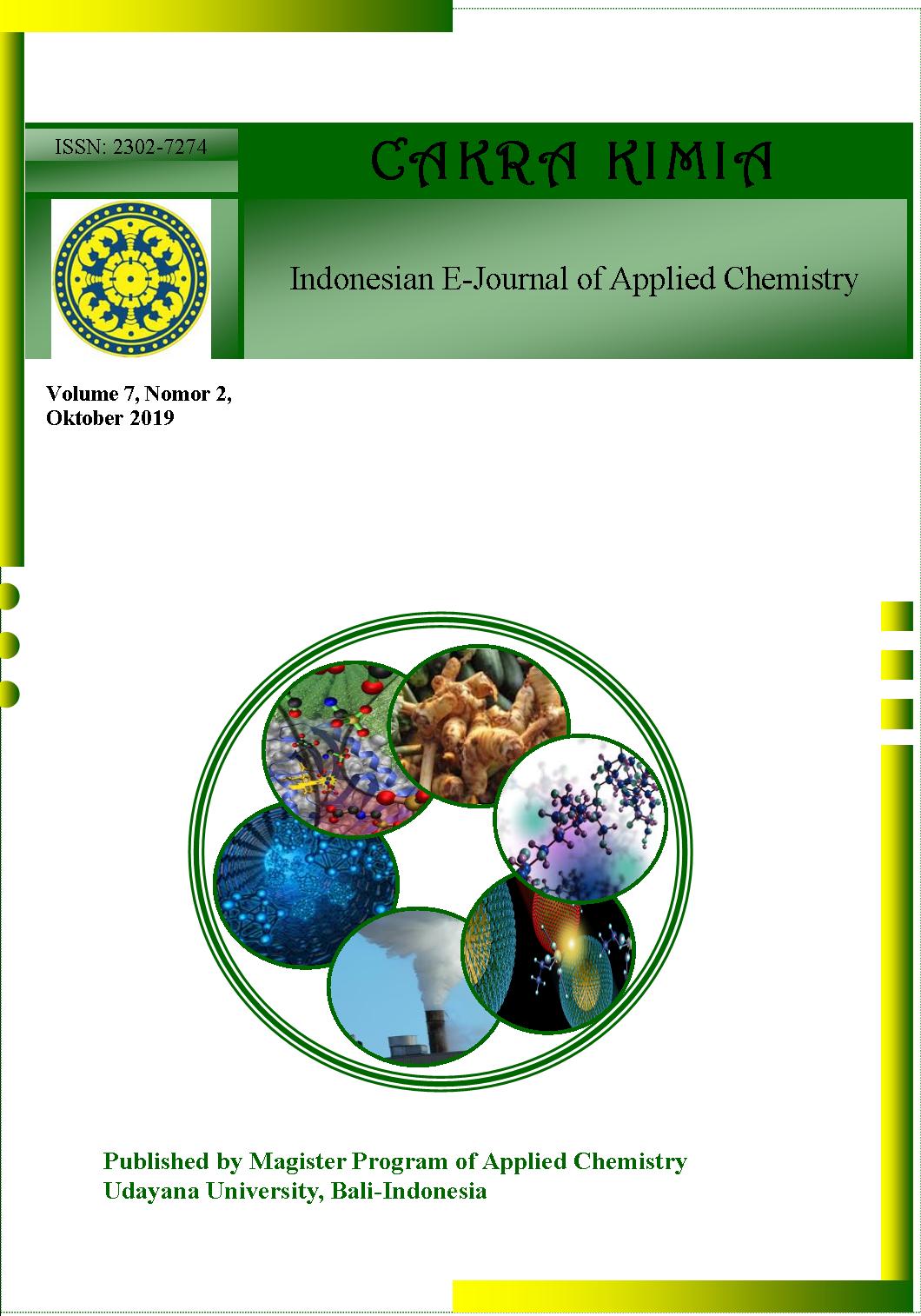ADSORPSI ION Pb(II) OLEH ZEOLIT ALAM ENDE TERAKTIVASI ASAM: STUDI PENGEMBANGAN MINERAL ALTERNATIF PENJERAP LIMBAH LOGAM BERAT
Abstract
ABSTRAK: Peningkatan kapasitas adsorpsi dan efisiensi penyerapan zeolit alam Ende - NTT sudah dilakukan melalui proses aktivasi kimia. Penelitian ini bertujuan untuk menghasilkan adsorben yang efektif mengurangi kadar logam Pb(II) dalam larutan. Aktivasi zeolit alam tersebut dilakukan dengan memvariasikan konsentrasi asam klorida (HCl) dan dikarakterisasi menggunakan Difraksi Sinar-X (XRD) dan Scanning Electron Microscope (SEM). Sementara proses adsorpsi ion Pb(II) menggunakan zeolit alam teraktivasi tersebut dipelajari pada variasi pH dan waktu kontak. Konsentrasi ion Pb(II) sebelum dan sesudah penyerapan ditentukan dengan instrumen Spektrofotometer Serapan Atom (SSA). Hasil penelitian menunjukkan bahwa konsentrasi optimum HCl untuk proses aktivasi tersebut adalah 3,0 M. Kondisi optimum penyerapan ion logam tersebut terjadi pada pH 4 dan waktu kontak selama 60 menit. Kapasitas adsorpsi dan efisiensi penyerapan maksimum zeolit alam terhadap ion logam Pb(II) berturut-turut sebesar 24.843 mg/g dan 99.37%.
Kata kunci: zeolit alam, adsorpsi, aktivasi, logam berat, timbal (II)
ABSTRACT: The improvement of adsorption capacity and absorption efficiency of natural zeolite from Ende - NTT has been carried out by chemical process activation using chloric acid (HCl). The purpose of this research was to produce adsorbent that efectively reduce the Pb(II) concentration from solution. The adsorption of the activated natural zeolite on Pb (II) was studied by varying the HCl concentration, pH of the solution, and contact time. The characterization of the activated natural zeolite was conducted with X-Ray Diffraction (XRD) and Scanning Electron Microscope (SEM). Meanwhile the concentration of ion Pb (II) was measured by Atomic Absorption Spectrophotometer (AAS). The optimum HCl concentration for the activation process was 3.0 M. Moreover, the optimum pH of the solution and contact time were 4 and 60 minutes respectively with the adsorption capacity and the efficiency were 24.843 mg/g and 99.37% respectively.
Downloads
References
[2] Said N.I. Metode penghilangan logam berat (As, Cd, Cr, Ag, Cu, Pb, Ni, Zn) di dalam air limbah industri. Jurnal Air Indonesia. 2010, 6(2), 136-148.
[3] Khodadadi M., Ansaritabar M., Malekpour A. Removal of Pb(II) and Cu(II) from aqueous solutions by NaA zeolite coated magnetic nanoparticles and optimization of method using experimental design. Microporous and Mesoporous Materials. 2017, 248, 256-265.
[4] Javanbakht V., Ghoreishi S.M., Habibi N., Javanbakht M. Anovel magnetic chitosan/ clinoptilolite/ magnetite nanocomposite for highly efficient removal of Pb(II) ions from aqueous solution. Powder Technology. 2016, 302, 372-383.
[5] Milani M.B., Ejhieh A.N. A comprehensive study on photocatalytic activity of supported Ni/Pb sulfide and oxide system onto natural zeolite nanoparticles. Journal of Hazardous Materials. 2016, 318, 291-301.
[6] Keputusan Menteri Negara Lingkungan Hidup No. 5 tahun 2014 tentang baku mutu limbah cair bagi kegiatan industri. 2014. Jakarta: Pemerintah Republik Indonesia.
[7] Standar Nasional Indonesia. SNI 01-3553-2006. Air minum dalam kemasan. 2006. Jakarta: Badan Standardisasi Nasional.
[8] Chen G., Shah KJ., Shi L., Chiang PC. Removal of Cd(II) and Pb(II) ions from aqueous solutions by synthetic mineral adsorbent: performance and mechanisms. Applied Surface Science. 2017, 409, 296-305.
[9] Pandey P.K., Sharma S.K., Sambi S.S. Removal of lead(II) from waste water on zeolite-NaX. Journal of Enviromental Chemichal Engineering. 2015, 3(4), 2604-2610.
[10] Zhu L., Ji J., Wang S., Xu C., Yang K., Xu M. Removal of Pb(II) from wastewater using Al2O3-NaA zeolite composite hollow fiber membranes synthesized from solid waste coal fly ash. Chemosphere. 2018, 206, 278-284.
[11] Lu X., Wang F., Li X., Shih K., Zeng EY. Adsorption and thermal stabilization of Pb2+ and Cu2+ by zeolite. Industrial and Engineering Chemistry Research. 2016, 55(32), 8767-8773.
[12] Gougazeh M., Buhl J.C. Synthesis and characterization of zeolite A by hydrothermal transformation of natural Jordanian kaolin. Journal of the Association of Arab Universities for Basic and Applied Science. 2014, 15, 35-42.
[13] Arryanto., Suwardi., Husaini., Affandi T., Amini S., Al-Jabri M., Siagian P., Setyorini D., Rahman A., Pujiastuti Y. Zeolit dan masa depan bangsa. Yogyakarta (ID), Imperium Pr, 2012.
[14] Ngapa Y.D., Sugiarti S., Abidin Z. Hydrothermal transformation of natural zeolite from Ende-NTT and its application as adsorbent of cationic dye. Indones. J. Chem. 2016, 16(2), 138-143.
[15] Ngapa Y.D. Kajian pengaruh asam-basa pada aktivasi zeolit dan karakterisasinya sebagai adsorben pewarna biru metilena. JKPK (Jurnal Kimia dan Pendidikan Kimia). 2017, 2(2), 90-96.
[16] Parast Z.V., Asilian H., Jafari A.J. Adsorption of xylene from air by natural Iranian zeolite. Health Scope. 2014, 3(3), 1-8.
[17] Cardoso A., Horn M., Ferret L., Azevedo C., Pires M. Integrated synthesis of zeoliten 4A and Na-P1 using coal fly ash for application in the formulation of detergent and swine wastewater treatment. Journal of Hazardous Materials. 2015, 287, 69-77.
[18] Djaeni M., Kurniasari L., Purbasari A., Sasongko S. Proceeding of the 1st International Conference on Materials Engineering. 2010, November 25 – 26, Yogyakarta.
[19] Alshameri A., Yan C., Al-ani Y., Dawood S., Ibrahim A., Zhou C., Wanga H. Journal of the Taiwan Institute of Chemichal Engineers. 2014, 45(2), 554-564.
[20] Wang X., Shao D., Hou G., Wang X. Uptake of Pb(II) and U(IV) ions from aqueous solutions by the ZSM-5 zeolite. Journal of Moleculer Liquids. 2015, 207, 338-342.
[21] Sharifipour F., Hojati S., Cano F.C. Kinetics and thermodynamics of lead adsorption from aqueous solutions onto Iranian sepiolite and zeolite. Int. J. Environ. Res. 2015, 9(3), 1001-1010.



 Petunjuk Penulisan
Petunjuk Penulisan
